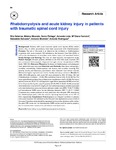Mostrar o rexistro simple do ítem
Rhabdomyolysis and acute kidney injury in patients with traumatic spinal cord injury
| dc.contributor.author | Galeiras, Rita | |
| dc.contributor.author | Mourelo-Fariña, Mónica | |
| dc.contributor.author | Pértega-Díaz, Sonia | |
| dc.contributor.author | Lista, Amanda | |
| dc.contributor.author | Ferreiro-Velasco, María Elena | |
| dc.contributor.author | Salvador-de-la-Barrera, S. | |
| dc.contributor.author | Montoto Marqués, Antonio | |
| dc.contributor.author | Rodríguez, Antonio | |
| dc.date.accessioned | 2022-06-14T08:24:05Z | |
| dc.date.available | 2022-06-14T08:24:05Z | |
| dc.date.issued | 2016-09 | |
| dc.identifier.citation | Galeiras R, Mourelo M, Pértega S, Lista A, Ferreiro ME, Salvador S, Montoto A, Rodríguez A. Rhabdomyolysis and acute kidney injury in patients with traumatic spinal cord injury. Indian J Crit Care Med. 2016 Sep;20(9):504-12. doi: 10.4103/0972-5229.190370. PMID: 27688625; PMCID: PMC5027742. | es_ES |
| dc.identifier.issn | 0972-5229 | |
| dc.identifier.uri | http://hdl.handle.net/2183/30912 | |
| dc.description.abstract | [Abstract] Background: Patients with acute traumatic spinal cord injuries (SCIs) exhibit factors that, in other populations, have been associated with rhabdomyolysis. Purpose: The aim of the study is to determine the incidence of rhabdomyolysis in patients with acute traumatic SCI admitted to the Intensive Care Unit (ICU), as well as the development of secondary acute kidney injury and associated factors. Study design and setting: This was an observational, retrospective study. Patient sample: All adult patients admitted to the ICU with acute traumatic SCI who presented rhabdomyolysis, diagnosed through creatine phosphokinase (CPK) levels >500 IU/L. Outcome measures: Incidence of rhabdomyolysis and subsequent renal dysfunction was calculated. Materials and methods: Data about demographic variables, comorbidity, rhabdomyolysis risk factors, and variables involving SCI, severity scores, and laboratory parameters were obtained from clinical records. Multivariate logistic regression was used to identify renal injury risk factors. Results: In 2006-2014, 200 patients with acute SCI were admitted to ICU. Of these, 103 had rhabdomyolysis (incidence = 51.5%; 95% confidence interval [CI]: 44.3%-58.7%). The most typical American Spinal Injury Association classification was A (70.3%). The injury severity score was 30.3 ± 12.1 and sequential organ failure assessment (SOFA) score was 5.6 ± 3.3 points. During their stay, 57 patients (55.3%; 95% CI: 45.2%-65.4%) presented renal dysfunction (creatinine ≥1.2 mg/dL). In the multivariate analysis, variables associated with renal dysfunction were creatinine at admission (odds ratio [OR] = 9.20; P = 0.006) and hemodynamic SOFA score the day following admission (OR = 1.33; P = 0.024). Creatinine was a better predictor of renal dysfunction than the peak CPK value during the rhabdomyolysis (area under the receiver operating characteristic curve: 0.91 vs. 0.63, respectively). Conclusions: Rhabdomyolysis is a frequent condition in patients with acute traumatic SCI admitted to the ICU, and renal dysfunction occurs in half of the cases. Creatinine values should be requested starting at the admission while neither the peak CPK values nor the hemodynamic SOFA scores could be used to properly discriminate between patients with and without renal dysfunction. | es_ES |
| dc.language.iso | eng | es_ES |
| dc.publisher | Wolters Kluwer | es_ES |
| dc.relation.uri | https://doi.org/10.4103/0972-5229.190370 | es_ES |
| dc.rights | Atribución-NoComercial-SinDerivadas 3.0 España | es_ES |
| dc.rights.uri | http://creativecommons.org/licenses/by-nc-nd/3.0/es/ | * |
| dc.subject | Acute kidney injury | es_ES |
| dc.subject | Rhabdomyolysis | es_ES |
| dc.subject | Spinal cord injuries | es_ES |
| dc.title | Rhabdomyolysis and acute kidney injury in patients with traumatic spinal cord injury | es_ES |
| dc.type | info:eu-repo/semantics/article | es_ES |
| dc.rights.access | info:eu-repo/semantics/openAccess | es_ES |
| UDC.journalTitle | Indian Journal of Critical Care Medicine | es_ES |
| UDC.volume | 20 | es_ES |
| UDC.issue | 9 | es_ES |
| UDC.startPage | 504 | es_ES |
| UDC.endPage | 512 | es_ES |
Ficheiros no ítem
Este ítem aparece na(s) seguinte(s) colección(s)
-
INIBIC-ECB - Artigos [50]






